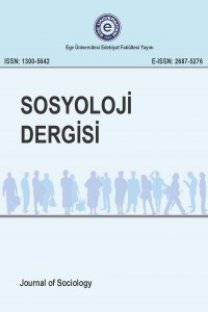Göstergebilimsel bir Yaklaşım: Beyoğlu'nda Postmodern Sosyal Okumalar
Beyoğlu, Kültürlerin Dikotomisi, Arabesk, Tüketim
A SEMIOTICAL APPROACH: POSTMODERN SOCIAL READINGS IN BEYOGLU
Beyoğlu, Dichotomy of Cultures, Arabesque, Consumer,
___
- Akın, N., 1998, 19. Yüzyılın İkinci Yarısında Galata ve Pera, Literatür Publishing, Istanbul
- Barthes, R.,1993, L’aventure Semiologique, “Göstergebilimsel Serüven”, Trans: Mehmet Rıfat & Sema Fırat ,Yapı Kredi Publishing, İstanbul
- Bartu, A., 1999, “Eski Mahallelerin Sahibi Kim? Küresel Bir Çağda Tarihi Yeniden Yazmak”, in Küresel ve Yerel Arasında, Metis Publishing, İstanbul
- Baudrillard, J., 1993, The Transparency of Evil, Verso : London
- Eco, U. 1976, A Theory of Semiotics, Indiana University Press, Bloomington
- Featherstone,M.,1991, Consumer Culture and Postmodernism, Sage Publications
- Fine, G.A., 2008, “Culture and Microsociology: The Anthill and the Veldt, Annales of the American Academy of Political and Social Science, Vol. 619, Cultural Sociology and its Diversity, pp. 130-148
- Gottdiener, M., 1985, “Hegemony and Mass Culture: A Semiotic Approach”, American Journal of Sociology, Vol. 90, pp. 979-1001
- Gottdiener, M., 1995, "Recapturing the Center: A Socio-Semiotic Analysis of Shopping Malls." Postmodern Semiotics: Material Culture and the Forms of Postmodern Life. Blackwell Publishers, Oxford
- Greimas, A., 1986, For a Topological Semiotics, The City and the Sign: An Introduction to Urban Semiotics, Columbia University Press, New York
- Gürses, D., 2010, “Globalization and Social Polarization in Istanbul, Conference Papers”, American Sociological Association , Annual Meeting, p 522-522,
- Harvey, D., 1989, The Condition of Postmodernism, Blackwell Publishers, Oxford
- Hewison, R., 1987, The Heritage Industry, Methuen Publishing, London
- Idemen, S., Düzkan, H., 2004, İşgal, Sürgün, Yağma, (Occupation, Exile, Looting), Express Magazine, İstanbul, 22-august – 22 september, pp. 16-19
- Jameson, F., 1984, “Postmodernism or the Cultural Logic of Late Capitalism”, New Left Review, 146, pp. 53-93 , “Postmodernizm Ya Da Geç Kapitalizmin Kültürel Mantığı” in “Postmodernizm”, Trans: Deniz Erksan, ed.: Necmi Zeka, Kiyi Publishing, 1990, Istanbul
- Jencks, C., 1984, The Language of Postmodern Architecture, London
- Kahraman, H.B., 2002, Postmodernite ve Modernite Arasında Türkiye, Agora, Istanbul
- Keyder, Ç., 1999, Istanbul Between the Global and the Local, Rowman & Littlefield Publishers, Boston-Maryland
- Krampen, M., 1979, Meaning in the Urban Environment, Pion, London
- Lash,S., 1994, Economics of Sign and Space, Sage, London
- Levin, P., 2008, “Culture and Markets: How Economic Sociology Conceptualizes Culture”, Annals of the American Academy of Political and Social Science, Vol. 619, Cultural Sociology and Its Diversity, pp. 114-129.
- Mills, A., 2005, “ Narratives in City Landscapes: Cultural Identity in Istanbul”, The Geographical Review, 95 (3), pp. 441 - 462
- Mounin, G., 1980, “The Semiology of Orientation in Urban Space”, Current Antropolgy, Vol. 21, No. 4, pp. 491- 501
- Özbek, M., 1997, “Arabesk Culture: A Case of Modernization and Popular Identity” in Rethinking Modernity and National Identity in Turkey, ed.: Sibel Bozdoğan and Reşat Kasaba, University of Washington Press, Seattle and London, pp. 211- 233
- Secor, A., 2004, “There is an Istanbul That Belongs to Me”: Citizenship, Space, and Identity in the City, Annals of the Association of American Geographers, 94 (2), pp. 352-368
- Simmel, G., 2005, Metropol ve Zihinsel Yaşam, “Şehir ve Cemiyet” içinde, ed. Ahmet Aydoğan, Iz Publishing, Istanbul
- Tedman, G., 2010, “Origins of Kitsch, Rethinking Marxism: A journal of Economics, Culture& Society, Association for Economic and Social Analysis, 22:1, pp. 56- 67
- Thorns, D., 2004, The Transformation of Cities, Macmillan Publishers, Translation: “Kentlerin Dönüşümü” Esra Nal, Hasan Nal, Global Publishing, İstanbul
- Yarar, B., 2008, “ Politics of/and Popular Music An analysis of the History of Arabesk Music from the 1960’s to the 1990’s in Turkey”, Cultural Studies, Vol. 22, No.1, pp. 35-79
- Yağcı, E., 2005, Beyoğlu Bölgesi’nde Sosyolojik Değişime Bağlı Yapısal Çevre Gelişimi, Unpublished Notes, Ankara
- Yumul, A., 2009, “ A Prostitute Lodging in the Bosom of Turkishness”: Istanbul’s Pera and its Representation, Journal of Intercultural Studies, Vol.30, No.1, pp. 57-72
- ISSN: 1300-5642
- Yayın Aralığı: Yılda 2 Sayı
- Başlangıç: 1987
- Yayıncı: Ege Üniversitesi, Edebiyat Fakültesi
ÖNCESİ VE SONRASI: ERMENİSTAN’DAN TÜRKİYE’YE İŞGÜCÜ GÖÇÜNÜN NEDENLERİ VE GÖÇMEN İLİŞKİ AĞLARI
HOMO ABSURDUS KURAMI İÇİN BİR BAŞLANGIÇ: THORSTEİN VEBLEN’DEN VE JEAN BAUDRİLLARD’A DEĞİŞEN TEMALAR
Alan W DYER, Mehmet Emin BALCI
HANNAH ARENDT: DEMOKRASİ VE POLİTİK OLAN
Göstergebilimsel bir Yaklaşım: Beyoğlu'nda Postmodern Sosyal Okumalar
HOMO ABSURDUS KURAMI İÇİN BİR BAŞLANGIÇ: THORSTEİN VEBLEN’DEN VE JEAN BAUDRİLLARD’A DEĞİŞEN TEMALAR
Alan W DYER, Mehmet Emin BALCI
ÜNİVERSİTEDE GÖZETİM VE KONTROL
FACEBOOK GRUPLARINDA “FUTBOL” ALGISI ÜZERİNDEN BİR “TARAFTARLIK” KİMLİĞİ ÇÖZÜMLEMESİ
FACEBOOK GRUPLARINDA “FUTBOL” ALGISI ÜZERİNDEN BİR “TARAFTARLIK” KİMLİĞİ ÇÖZÜMLEMESİ
ÖNCESİ VE SONRASI: ERMENİSTAN’DAN TÜRKİYE’YE İŞGÜCÜ GÖÇÜNÜN NEDENLERİ VE GÖÇMEN İLİŞKİ AĞLARI
